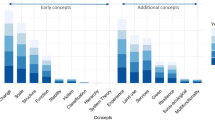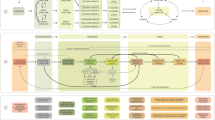Abstract
Framework, concepts, and methods of Environmental Management Planning (EMP) are discussed. A landscape-ecological approach was taken to integrate the environmental indices. EMP focuses on regional factors- natural, social, amenity related — and becomes more sensitive as the scale of study increases. The processes of EMP include a vertical aspect, dealing with pollution, conservation, and amenities, and a more general horizontal component which involves zoning and land use planning. Environmental impacts may be assessed by modeling exercises using all available data and considering all land use options. To keep up with the rapid change of environment and its perception, EMP should be process-oriented rather than purpose-oriented. The concepts of EMP were applied to the middle basin of the Tamagawa River and it was shown that mulvariate analysis is useful for the regional subdivision and environmental modeling.
Similar content being viewed by others
References
Abe, T. 1987. Environmental management in urban areas. City Plann. Rev. Japan 150: 50–55 (in Japanese with English abstract).
Amoros, C., Rostan, J.C., Pautou, G. and Bravard, J.P. 1987. The reversible process concept applied to the environmental management of large river systems. Environ. Manage. 11(5): 607–617.
Aoyama, T. 1987. On environmental management planning method. Environ. Inf. Sci. 16(2): 8–15 (in Japanese).
Ayala, H.L. 1987. New view of environmental health — toward an environmental research policy for international strategies. Environ. Manage. 11(2): 141–147.
Bartkowski, T. and Zimowski, L. 1984. Ecologically oriented education of physical planners and architect, pp. 7–26. Panstwowe Wydauinictwo Naukowe.
Berry, J.L. 1987. A mathematical structure for analyzing maps. Environ. Manage. 11(3): 317–325.
Bowonder, B. 1987. Integrating perspective in environmental management. Environ. Manage. 11(3): 305–315.
Conacher, A. 1980. Environmental problem-solving and land-use management — a proposed structure for Australia. Environ. Manage. 4(5): 391–405.
Cooke, R.V. and Doornkamp, V.C. 1974. Geomorphology in environmental management. Clarendon Press, Oxford.
Drdos, J. (ed.) 1983. Landscape synthesis — geoecological foundations of the complex landscape management, pp. 201–212, VEDA.
Duinker, P.N. and Baskerville, G.L. 1986. A systematic approach to forecasting in environmental impact assessment. J. Environ. Manage. 23(3): 271–290.
Duinker, P.N. and Beanlands, G.E. 1986. The significance of environmental impacts — an exploration of the concept. Environ. Manage. 10(1): 1–10.
Gregory, K.J. and Walling, D.E. (ed.) 1979. Man and environmental processes — a physical geography perspective, pp. 241–258. Dawson Westview Press.
Griffith, C. 1980. Geographic information systems and environmental impact assessment. Environ. Manage. 4(1): 21–25.
Harasawa, H. and Nishioka, S. (eds) 1987. Studies on environmental information system for environmental evaluation. Res. Rep. Nat. Inst. Environ. Studies, Japan 109: 109 (in Japanese with English abstract).
Hayashi, C. and Suzuki, T. 1975. Quantitative approach to cross-societal research a comparative study of Japanese character. Ann. Inst. Statist. Math. 27(1): 27–32.
Himi, Y. 1987. Backgrounds of environmental management planning and practical issues in Kanagawa. Environ. Inf. Sci. 16(2): 29–36 (in Japanese).
Hiwatashi, T. 1987. Conservation and resuscitation of the waterfront area. City Plann. Rev. Japan 150: 62–67 (in Japanese with English abstract).
Holdgate, M.W. and White, G.F. 1976. Environmental issues. ICSU-SCOPE.
Hushon, J.M. 1987. Expert system for environmental problems. Environ. Sci. & Technol. 21(9): 838–841.
Ide, H. 1975. Conception and planning of landscape. City Plann. Rev. Japan 83: 10–13 (in Japanese with English abstract).
Inoue, K. 1987. Environmental evaluation for life in urban areas. City Plann. Rev. Japan 150: 46–49 (in Japanese with English abstract).
Itoga, R. 1986. Brief summary of landscape researches since 1955 in Japan. J. Jap. Inst. Landscape Archit. 50(2): 118–122 (in Japanese with English abstract).
Isobe, Y., Shapiro, H.A., Ito, T. and Regional Planning Team 1975. 1977. Ecological planning: its method and application. Kenchiku Bunka 30(344): 49–136, 32(367): 31–152.
Kaneko, T. 1986. Fundamental study on the management of greenspace in the urban residential district. J. Jap. Inst. Landscape Archit. 49(5): 263–268 (in Japanese with English abstract).
Karr, J.R. 1987. Biological monitoring and environmental assessment — a conceptual framework. Environ. Manage. 11(2): 249–256.
Kiemstedt, H., Gildeneister, R., Haber, W. Koeppel, H-D., Mrass, W., Schönnamsgruber, H. and Tomašek, W. 1976. Inhalte and Verfahrensweisen der Landschaftsplanung. Stellungnahme des Beirats für Naturschutz und Landschaftspflege beim BML, Bonn-Duisdorf.
Kihara, T. 1987. On the municipal ordinance for environmental conservation of Koshigaya City. Environ. Inf. Sci. 16(1): 61–66 (in Japanese).
Koeppel, H. and Arnold, F. 1981. Landschaftsinformations-system. Schriftenreihe für Landschaftspflege and Naturschutz 21.
Kubo, S. 1986. The development of geographic information systems in Japan. Proc. 24th URISA Conf., Denver, Colorado.
Kurasawa, S. (ed.) 1986. Social atlas of Tokyo. Univ. Tokyo Press, Tokyo.
Lant, P. and Paine, T.A. 1982. A step towards an objective procedure for land classification and mapping. Appl. Geogr. 2: 109–126.
Leser, H. 1983. Stand Geoökologischer Forschung Heute und Fortschitte. Geoökologie: 212–221.
Leser, H. 1984. Zum Ökologie-, Ökosystem- und Ökotop- begriff. Natur und Landsch. 59(9): 351–357.
Maruyama, K., Hayashi, F. and Kamisasa, H. 1981. A multivariate analysis of Japanese attitude toward life and death. Behaviormetrika 10: 35–48.
Mazurski, K.R. 1987. Suggestions for terminology for changes in the natural environment. Biol. Wastes 22(1): 1–9.
Morita, T., Noda, K. and Horiuchi, Y. 1985 A computation of environmental indices according to evaluation by urban residents — for environmental management in Kitakyushu City. Pap. Ann. Conf. City Plann. Inst. Japan 20: 133–138 (in Japanese with English abstract).
Naito, M., Nishioka, S. and Harashina, S. (eds) 1986. Environmental indices — basic notion and formation. Gakuyo-shobo, Tokyo (in Japanese).
OECD 1977. Environmental policies in Japan. OECD, Paris.
Okajima, T. 1987. Regional environmental management planning in Shiga — Lakeland Environmental Plan. Environ. Inf. Sci. 16(2): 22–28 (in Japanese).
Petak, W.J. 1980. Environmental planning and management — the need for an integrative perspective. Environ. Manage. 4(4): 287–295.
Petak, W.J. 1981. Environmental management — a system approach. Environ. Manage. 5(3): 213–224
Roberts, M.C., Randolph, J.C. and Chiesa, J.R. 1979. A land suitability model for the evaluation of land-use change. Environ. Manage. 3(4): 339–352.
Ryan, D.R. 1982. Environmental regulation — a new approach. Environ. Manage. 6(2): 95–100.
Shimada, N., Shakudo, O., Ito, N. and Onodera, H. 1985. Environmental conservation policies in the nation wide land. J. Jap. Inst. Landscape Archit. 48(4): 227–233 (in Japanese).
Simmons, I.G. 1979. Biogeography — natural and cultural, pp. 331–346. Edward Arnold, London.
Smith, P.G.R. and Theberge, J.B. 1986. A review of criteria for evaluating natural areas. Environ. Manage. 10(6): 715–734.
Sokolik, S.L. 1986. Environmental audit-III. Improving the management of environmental information for toxic substances. Environ. Manage. 10(3): 311–317.
Stanrowe, J. and Sheard, J.W. 1981. Ecological and classification — a survey approach. Environ. Manage. 5(5): 451–464.
Steiner, F. and Brooks, K. 1981. Ecological planning — a review. Environ. Manage. 5(6): 495–505.
Steiner, F. 1983. Resource suitability — methods for analyses. Environ. Manage. 7(5): 401–420.
Suzuki, M., Shinji, I., Kihara, K. and Igarashi 1986. Social condition and the problems of landscape in recent years. J. Jap. Inst. Landscape Archit. 49(5): 79–84 (in Japanese with English abstract).
Takeuchi, K. 1982. Fundamental concepts on landscape-capability classification. J. Rural Plann. Assn. 1(2): 10–15 (in Japanese with English abstract).
Takeuchi, K. 1983. Landscape planning methodology based on geoecological land evaluation. GeoJournal 7(2): 167–183.
Takeuchi, K. 1984. A numerical approach to the landscape classification of municipalities in Saitama Prefecture, Central Japan. Geogr. Rep. Tokyo Metropol. Univ. 19: 175–184.
Takeuchi, K. 1987. Creating sound environment through applied landscape science. J. Jap. Inst. Landscape Archit. 50(3): 190–193 (in Japanese with English abstract).
Takeuchi, Kei 1987. The basic conception of regional environmental management plan. Environ. Inf. Sci. 16(2): 16–21 (in Japanese).
Tashiro, Y. andKobayashi, A. 1985. Parks and open space creation in urbanized area. J. Jap. Inst. Landscape Archit. 48(4): 234–241 (in Japanese with English abstract).
Troll, C. 1968. Landschaftsökologie. Pflanzensoziologie und Landschaftsökologie, pp. 1–21. Edited by R. Tüxen. Dr W. Junk Publishers, The Hague.
Utsunomiya, F. 1987. Backgrounds and objectives of environmental management planning. Environ. Inf. Sci. 16(2): 2–7 (in Japanese).
Weichhart, P. 1979. Remarks on the term ‘environment’. GeoJournal 3(6): 523–531.
White, L.D., Mottershead, D.N. and Harrison, S.J. 1986. Environmental systems. pp. 436–469. Allen & Unwin, London.
Author information
Authors and Affiliations
Rights and permissions
About this article
Cite this article
Takeuchi, K., Lee, DK. A framework for environmental management planning — A landscape-ecological approach. Landscape Ecol 3, 53–63 (1989). https://doi.org/10.1007/BF00157756
Issue Date:
DOI: https://doi.org/10.1007/BF00157756




